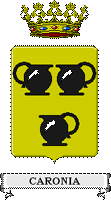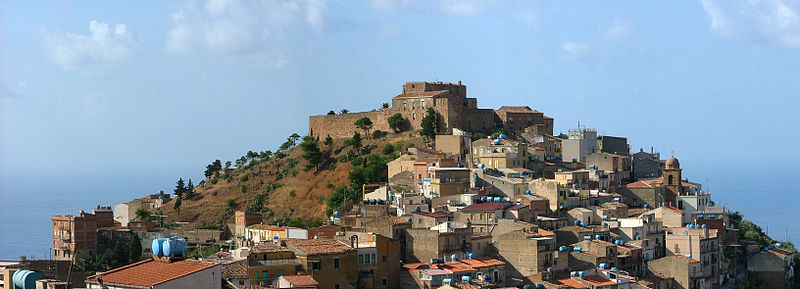

Caronia si trova sull'omonimo monte da cui prende il nome anche la catena montuosa dei nebrodi detti anche "Caronie". Il territorio comprende la zona montana a 300 mt. s.l.m. e quella marina.
Si fa risalire il primo nucleo abitato intorno all'VIII sec. a.C. ad opera dei greci che le diedero il nome di Kale Acte (bella costa) ma lo storico Diodoro Siculo imputa la sua fondazione al 447 a.C. da parte di Ducezio, di ritorno dall'esilio da Corinto con alcuni abitanti della stessa, che fondarono la città di Calacte e al cui centro si sarebbe sviluppato il centro urbano nel periodo ellenistico. In contrada Telegrafo dell'attuale Caronia sono state rinvenute le mura perimetrali dell'antica città in pietra e mattoni.
Dopo la conquista romana del II sec. a.C. la città acquisto importanza tanto da battere le proprie monete in bronzo. Durante l'impero romano fu un rilevante centro agricolo e commerciale: esportava soprattutto vino, ma anche tonno e Silio Italico nel I secolo d.C. parlava del "litus piscosa Calacte". Anfore vinarie del IV sec. d.C. prodotte a Caleacte sono state trovate a Roma.
Dai recenti scavi emerge che la città ellenistica fu distrutta a causa di un terremoto o un incendio intorno al I sec. d.C. , gli abitanti si spostarono sul mare ma a metà del sec. IV d.C. anche questo fu distrutto e l'abitato di Calacte proseguì in forma ridotta.
Il toponimo caronia (Al Qaruniah) viene menzionato nel XII sec. ad opera del geografo arabo l'Drisi nell'opera conosciuta come "Il libro di Ruggero" (il sollazzo per chi si diletta a girare il mondo) in cui è citato il Castello Normanno (..."sorge una fortezza di nuova costruzione"...). Dello stesso periodo sono anche la chiesa di S. Nicolò e quella della SS. Annunziata a Caronia marina.
Dopo il periodo normanno Caronia fu feudo delle maggiori famiglie dell'epoca dai Ventimiglia a Matteo Palici, a Blasco Aragona, ad Enrico Rosso fino a Ettore Pignatelli nel 1544 la cui famiglia ebbe dei possedimenti sino a poco tempo fa ed il cui vessillo è rappresentato nello stemma comunale con tra pignatte in campo senape.
Le tracce delle antiche vestigia si possono rinvenire su molti monumenti e frammenti di opere così come nelle due torri medievali.
Nel dopoguerra oltre tremila ettari dei latifondi furono suddivisi e assegnati ai contadini.
Il panorama del paese è dominato dal castello, oggi di proprietà privata, le cui finestrelle sono sormontate da arcate ogivali. È un complesso fortificato con cinta muraria di forma triangolare e con torri. All'interno delle mura è il palazzo a due piani, di cui solo il primo, destinato a deposito non presenta finestre ed il secondo, destinato parzialmente ad abitazione, presenta elementi decorativi islamici. Esso, inoltre, ospita una cappella che, rara presenza in Sicilia, è a tre navate.
Tra i monumenti sono da ricordare: la Chiesa Madre dedicata a S. Nicolò del 1168 (all'interno sono visibili due quadri del XVIII sec. raffiguranti San Francesco di Paola e la Sacra Famiglia); la Chiesa di S. Biagio santo protettore di Caronia (all'interno la statua di S. Pietro e un dipinto sulla Deposizione del XVIII sec.); la Chiesa di S. Francesco (XVI sec.) e la Chiesa della Madonna Annunziata del XII sec. voluta dalla Regina Costanza.
(English)
Caronia is located on the homonymous mountain from which the Nebrodi mountain range also called "Caronie"takes its name. The territory includes the mountain area at 300 meters. s. l. m. and the Marine One.
The first inhabited nucleus is traced back to the VIII century. BC by the Greeks who gave it the name of Kale Acte (beautiful coast) but the historian Diodorus Siculus attributes its foundation to 447 BC by Ducetio, returning from exile from Corinth with some inhabitants of the same, who founded the town of Calacte and whose center would have developed the urban center in the Hellenistic period. In Contrada Telegrafo of the current Caronia were found the perimeter walls of the ancient city in stone and brick.
After the Roman conquest in the II^ century B.C., the city gained importance so that it beat its own bronze coins.
During the Roman Empire it was an important agricultural and commercial center: it exported mainly wine, but also tuna and Silius Italicus, in the I^ century A.D., spoke about "litus piscosa Calacte". Wine amphoras of the IV^ century A.D., producted in Calacte, were found in Rome.
It comes out of the recent excavation that the Hellenistic town was destroyed by an earthquake or by a fire at about the 1st century A.D.; the inhabitants moved to a village near the sea but in the middle of the IV^ century A.D., this too was destroyed and the built-up area continued to exist in reduced form.
The toponym "Caronia" (Al Qaruniah) is mentioned in the XII^ century by the Arabian geographer l'Drisi, in the work known as "Libro di Ruggero" ( “the solace for those who delight in traveling the world) where the Norman Castle is mentioned (…”a newly built fortress stands”...).
Of the same period are also St. Nicolas Church and that of Our Holy Lady of Annunciation's in Caronia Marina.
After the Norman period, Caronia was a feud of the major families of the time, from the Ventimiglia to Matteo Palici, to Blasco Alagona, to Enrico Rosso up to Ettore Pignatelli, in 1544, whose family had possessions until recently, and whose banner is represented in the municipal coat of arms with three pots in mustard yellow background.
The traces of the ancient vestiges can be found on many monuments and fragments of works so as in the two medieval towers.
In the postwar period, more than three thousands hectars of the latifondiums were subdivided and assigned to the farm workers.
The panorama of the town is dominated by the castle, that nowadays is a private property, whose small windows are surmonted by pointed arches. It is a fortified complex with triangular castle walls and towers. Inside of the walls there is the two-storey building, whose just the first floor, used for storage, has no windows and the second one, partially intended for housing, has Islamic decorative elements. It also houses a chapel that, rare presence in Sicily, has three naves.
Among the monuments are to be remembered: the Mother Church, dedicated to St. Nicolas, that dates back to the 1168 (inside of it you can see two XVIII^ century paintings depicting Saint Francis of Paola and the Holy Family ); St. Blaise's Church, the patron saint of Caronia (inside of it the statue of St. Peter and a XVIII^ century painting of the Deposition); St. Francis Church (XVI^ century) and Our Lady Announcing dating back to the XII^ century, that the Queen Constance wanted to be built.